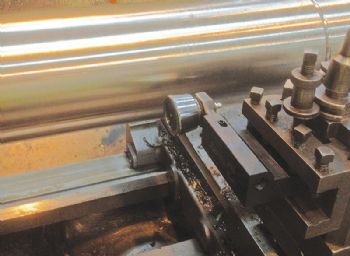
Following the introduction by Mollart Engineering (
mollart.com) of its Elliott roller burnishing tool range, one customer has been able to replace the separate — and time-consuming operations — of outer-diameter finish grinding and manual polishing on steel forming rolls with a single burnishing operation.
The manufacturer now creates — automatically — a consistently high surface finish over a 300mm length of the 150mm-
diameter 36NiCrMo4 alloy steel workpieces.
The change in processing that allows the use of an Elliott S2327 single-roll OD burnishing tool sees the roll shaft turned and then finish burnished in a single operation.
Moreover, the surface texture achieved (0.4 Ra) is twice as good as that specified. The burnishing tool is
run at the same 450rev/min as the finish turning operation, but at a feed rate of 0.1mm per rev.
Mollart sales manager Mark Dore said: “The customer elected to change processes due to problems of inconsistency from the manual polishing process and the time taken to achieve the specified finish. We were able to add the bonus of eliminating the grinding process plus the logistics of moving components around the workshop.”
The Elliott single-roll OD burnishing tool can be used on manual lathes, CNC lathes and machining centres, to create a controlled finish on diameters, angles, radii and faces. The contact roll can be supplied with radii between 0.8 and 3mm, to suit the application; and because it is made of carbide, its production life is good. Moreover, rolls can be easily replaced or refurbished.
In addition to achieving a high level of surface finish, the roller burnishing tool allows a constant size to be maintained, provided the pre-roll size tolerance is held.
The process also increases surface hardness, as it plasticises and generates a constant level of surface stress in the material (if this stress is higher than the yield strength of the material the surface begins to flow; and as the roll progresses across the material, any elastically deformed material springs back, pushing the deformed zone into a state of compression).
The surface peaks left from the pre-sizing operation are pressed down almost vertically as the material flows into the valleys, typically reducing the part diameter by 0.01mm.
The feed rate applied to the carbide roller suppresses the plasticised material and prevents any tendency of the flow to reverse. Meanwhile, the clearance angle applied to the roller ensures the surface does not become over burnished.